Views
Template Preprocess views view
Using template_preprocess_views_view you customize the view by adding or modifying variables. This is useful if you want to add a form to a view or add some other variable to the view. See more at the Drupal API link to function template_preprocess_views_view
Example 1
This is used in a custom module at /Users/selwyn/Sites/dir/web/modules/custom/dir/dir.module. It adds a form EventsByMonthForm which can be displayed on the view using the TWIG template. In the code, the view and display are identified and the $variables['events_by_month'] is added.
/**
* Implements template_preprocess_views_view().
*/
function dirt_preprocess_views_view(&$variables) {
$view = $variables['view'];
$view_name = $view->storage->id();
$display_id = $view->current_display;
if ($view_name == 'events_for_events_landing_page' && $display_id == 'upcoming') {
$variables['events_by_month'] = \Drupal::formBuilder()->getForm('Drupal\dir\Form\EventsByMonthForm');
}
}Example 2
This is a barebones example of how to modify a view using the template_preprocess_views_view() function. This would be stored in a custom module or .theme file. It modifies the view events by looping through the results and modifying each row as needed.
function dirt_preprocess_views_view(array &$variables) {
$view = $variables['view'];
// Check if this is a specific view.
if ($view->name == 'events') {
foreach ($view->result as $r => $result) {
// Modify each "row" as needed.
// For example, you can access fields like $result->field_name.
// Add your custom logic here.
}
}
// You can handle other views here if needed.
}Example 3
This version looks up the venue reference field and replace the node ID with the venue reference field's title.
function dirt_preprocess_views_view(array &$variables) {
$view = $variables['view'];
if ($view->name == 'events_landing_page') {
foreach ($view->result as $r => $result) {
$node = $result->_entity;
$venue = $node->get('field_venue')->entity;
// Replace the node ID with the venue reference field's title.
$variables['rows'][$r]['#row']->nid = $venue->getTitle();
}
}
// You can handle other views here if needed.
}Template Preprocess Views View Field
This is used to preprocess the output of a field in a view. It is a little more complex than the view preprocess function, but not much.
Example 1
This function from /Users/selwyn/Sites/txglobal/web/themes/custom/txglobal/txglobal.theme modifies the value of the nid field in the news_events_search view. It does some magic based on the nid field which is in the view and builds some stuff
/**
* Implements template_preprocess_views_view_field().
*/
function txglobal_preprocess_views_view_field(&$variables) {
$view = $variables["view"];
$viewname = $view->id();
$display = $variables["view"]->current_display;
if ($viewname == 'news_events_search' && $display == 'page_events') {
$field = $variables['field']->field;
if ($field == 'nid') {
$nid = $variables['output'];
if ($nid) {
$nid = $nid->__toString(); // Uh, it’s a Drupal render markup object- need string.
$node = Node::load($nid);
$node_type = $node->getType();
$aofs = _txglobal_multival_ref_data($node->field_ref_aof, 'aof', 'target_id');
$units = _txglobal_multival_ref_data($node->field_ref_unit, 'unit', 'target_id');
..
$related_items = array_merge($topics, $aofs, $units,$countries);
// New variable that will be readable in TWIG file
$variables['related_items'] = $related_items;
// Build a UL with a bunch of LI links in it
$links = '<ul>';
foreach ($related_items as $item) {
$links = $links . '<li><a href="/events/search?' . $item['param_name'] . '=' . $item['id'] . '">' . $item['title'] . '</a></li>';
}
$links .= '</ul>';
// Modify the actual output
// This outputs only text, not HTML so...
$variables['output'] = $links;
// Render it so you get legit HTML
$variables['output'] = \Drupal\Core\Render\Markup::create($links);
// OR add new variable that will be readable in TWIG file
$variables['related_items'] = \Drupal\Core\Render\Markup::create($links);
}
}
}
}Also of note here: To output the new variable put that in the twig file e.g. views-view-field--news-events-search--page-nid.html.twig (as in /Users/selwyn/Sites/txglobal/web/themes/custom/txglobal/templates/views/views-view--news-events-search--page-events.html.twig). The variable is output like this:
{{ related_items }}For completeness, here is the function that retrieves the values from the node and builds the array of related items.
/**
* Returns array of data for multivalue node reference fields.
*
* @param \Drupal\Core\Field\FieldItemListInterface $ref_field
* The entity reference field which we are building the links from.
* @param string $param_name
* Parameter name to be passed as get value.
* @param string $value_type
* Indicates which field to retrieve from database.
* @param string $field_ref_type
* Variable to determine type of reference field.
*
* @return array
* Array of data.
*
* @throws \Drupal\Component\Plugin\Exception\InvalidPluginDefinitionException
* @throws \Drupal\Component\Plugin\Exception\PluginNotFoundException
*/
function _txglobal_multival_ref_data(FieldItemListInterface $ref_field, $param_name, $value_type, $field_ref_type = 'node') {
$values = [];
$title = '';
if ($ref_field) {
foreach ($ref_field as $ref) {
if ($field_ref_type == 'taxonomy') {
$term = Drupal::entityTypeManager()
->getStorage('taxonomy_term')
->load($ref->$value_type);
if ($term) {
$title = $term->getName();
}
}
else {
if ($value_type == 'value') {
$title = $ref->$value_type;
}
else {
if (isset($ref->entity->title->value)) {
$title = $ref->entity->title->value;
}
}
}
$id = $ref->$value_type;
$values[] = [
'title' => $title,
'id' => str_replace(' ', '+', $id),
'param_name' => $param_name,
];
}
}
return $values;
}Example 2
Another version of ~/Sites/txglobal/web/themes/custom/txglobal/txglobal.theme which builds a UL of links based on the nid field in the view. It also uses a helper function to build the links. The helper function is in the same file and is called build_related_items_links().
/**
* Implements template_preprocess_views_view_field().
*
* This function replaces the nid field in the view with
* a UL of links.
*/
function txglobal_preprocess_views_view_field(&$variables) {
$view = $variables["view"];
$viewname = $view->id();
$display = $variables["view"]->current_display;
$displays = ['page_events', 'block_1', 'audience', 'program', 'unit'];
if ($viewname == 'news_events_search' || $viewname == 'events_for_this_anything') {
if (in_array($display, $displays)) {
$field = $variables['field']->field;
if ($field == 'nid') {
$nid = $variables['output'];
if ($nid) {
$nid = $nid->__toString();
$nid = intval($nid);
$node = Node::load($nid);
$related_items = build_related_items_links($node);
// Build the UL of related links.
$links = '<ul class="categories-block no-bullet">';
foreach ($related_items as $item) {
$links = $links . '<li><a href="/events/search?' . $item['param_name'] . '=' . $item['id'] . '">' . $item['title'] . '</a></li>';
}
$links .= '</ul>';
// Render it so you get legit HTML.
$variables['output'] = Markup::create($links);
}
}
}
}
}Here is the helper function that builds the links:
function build_related_items_links(Node $node) {
$node_type = $node->getType();
$collections = [];
$programs = [];
$topics = [];
$aofs = [];
$units = [];
$audiences = [];
$continents = [];
$countries = [];
if ($node->hasField('field_ref_aof')) {
$aofs = $node->field_ref_aof->target_id ? _txglobal_multival_ref_data($node->field_ref_aof, 'aof', 'target_id') : [];
}
if ($node->hasField('field_ref_unit')) {
$units = NULL !== $node->field_ref_unit->target_id ? _txglobal_multival_ref_data($node->field_ref_unit, 'unit', 'target_id') : [];
}
if ($node->hasField('field_ref_audience')) {
$audiences = NULL !== $node->field_ref_audience->target_id ? _txglobal_multival_ref_data($node->field_ref_audience, 'audience', 'target_id') : [];
}
if ($node->hasField('field_continent')) {
$continents = NULL !== $node->field_continent->value ? _txglobal_multival_ref_data($node->field_continent, 'continent', 'value', 'list') : [];
}
if ($node->hasField('field_ref_country')) {
$countries = NULL !== $node->field_ref_country->target_id ? _txglobal_multival_ref_data($node->field_ref_country, 'country', 'target_id') : [];
}
if ($node->hasField('field_ref_programs')) {
$programs = NULL !== $node->field_ref_programs->target_id ? _txglobal_multival_ref_data($node->field_ref_programs, 'program', 'target_id') : [];
}
if ($node->hasField('field_ref_program_collection')) {
$collections = NULL !== $node->field_ref_program_collection->target_id ? _txglobal_multival_ref_data($node->field_ref_program_collection, 'collection', 'target_id') : [];
}
if ($node->hasField('field_ref_topic')) {
$topics = NULL !== $node->field_ref_topic->target_id ? _txglobal_multival_ref_data($node->field_ref_topic, 'topic', 'target_id', 'taxonomy') : [];
}
$related_items = array_merge($topics, $aofs, $units, $audiences, $collections, $programs, $continents, $countries);
return $related_items;
}And the template
{%
set classes = [
dom_id ? 'js-view-dom-id-' ~ dom_id,
]
%}
<section class="content-section filter-search-form-section">
{{ title_prefix }}
{{ title }}
{{ title_suffix }}
{% set searchType = 'Events' %}
{% include '@txglobal/partials/searchfilterform.html.twig' %}
{% if header %}
<header>
{{ header }}
</header>
{% endif %}
{{ exposed }}
{{ attachment_before }}
<div class="grid-container">
<div class="grid-x grid-margin-x">
{% if rows -%}
{{ rows }}
{% elseif empty -%}
<div class="cell">
{{ empty }}
</div>
{% endif %}
{% if pager %}
<div class="cell small-12">
{{ pager }}
</div>
{% endif %}
</div>
</div>
{{ attachment_after }}
{{ more }}
{% if footer %}
<footer>
{{ footer }}
</footer>
{% endif %}
{{ feed_icons }}
</section>Example 3
This example has a view called selwyntest3 and a display called page_1. It modifies the nid field to output a specific value. In this case, there were two nid fields. Views refers to them as nid and nid_1. This shows how to find the correct field and modify the output. It is from ~/Sites/tea/docroot/themes/custom/tea/tea.theme.
function tea_preprocess_views_view_field(&$variables) {
$view = $variables['view'];
$view_name = $view->id();
$display_name = $view->current_display;
if ($view_name == 'selwyntest3' && $display_name == 'page_1') {
$field_name = $variables['field']->field;
if ($field_name == 'nid') {
/** @var Drupal\views\Plugin\views\field\EntityField $entity_field */
$entity_field = $variables['field'];
/** @var Drupal\Component\Plugin\Definition\PluginDefinition $plugin */
//$plugin = $entity_field->getPluginDefinition();
$options = $entity_field->options;
$view_field_machine_name = $options['id'];
if ($views_field_machine_name == 'nid_1') {
$program_nid = '825601';
$variables['output'] = $program_nid;
}
}
}
}Either Or in views
To show one field if it exists otherwise show another field is remarkably easy.
- Add a field for
field1and exclude it from display. - Add a field for
field2and exclude it from display. - Add a third field for
field2again - In the rewrite results put the token for
field2. Eg.[colorbox] - In the
No results behavior, put the token forfield1e.g.[field1].
Views Query options
When views give you unexpected results that seem permissions related, you can check the query options. This is a screenshot of the query options for a view. You can see the query options by clicking on the Advanced link in the view and then in the other section, click on Query settings. Sometimes it is useful to disable SQL rewriting as this bypasses security and returns the same data that you get as when you are logged in as user 1.
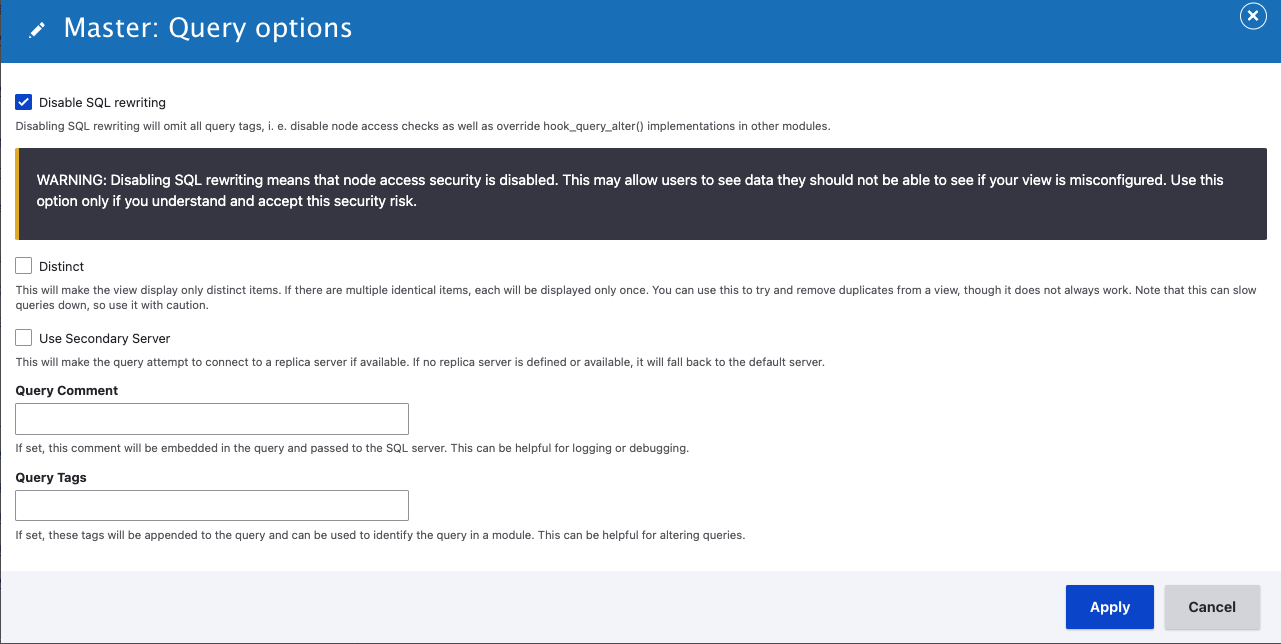
Note
The dialog will display this WARNING: Disabling SQL rewriting means that node access security is disabled. This may allow users to see data they should not be able to see if your view is misconfigured. Use this option only if you understand and accept this security risk.
Jump Menu
Using the Views Jump Menu module you can easily create a node driven no-code drop-down select box. The instructions are a bit confusing.
After installing (composer require 'drupal/views_jump_menu:^1.0@RC') and enabling the module, create a content type (e.g. jump_items) with a plain text field for a url. Don't use a link field. Create some jump_items nodes. e.g.
- Apple https://www.apple.com
- Microsoft https://www.microsoft.com
- Google https://www.google.com
- Node 10 /node/10
Note
You can use external or internal URL's as in the example above where we used a relative url /node/10
Create a view jump1. Add a block with a format of Jump Menu.
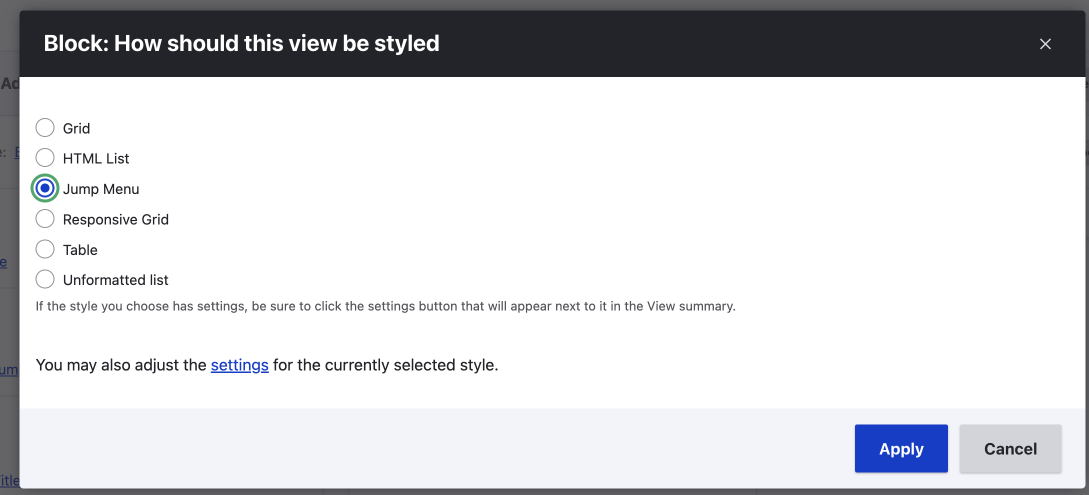
Add the fields that will be used for the jump menu. I used title field and link2 field.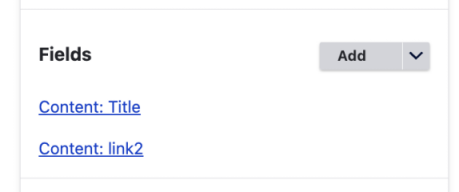
For the block format jump menu settings: 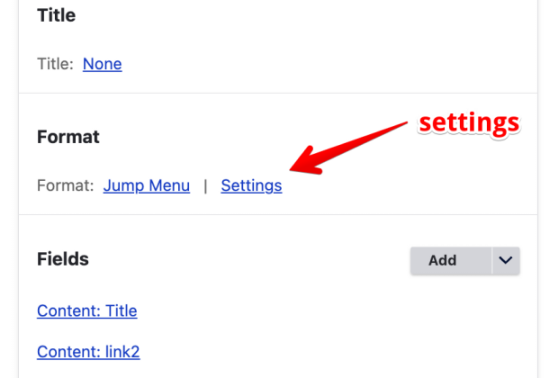
specify the label field and url field. Use the title and link2 fields respectively. 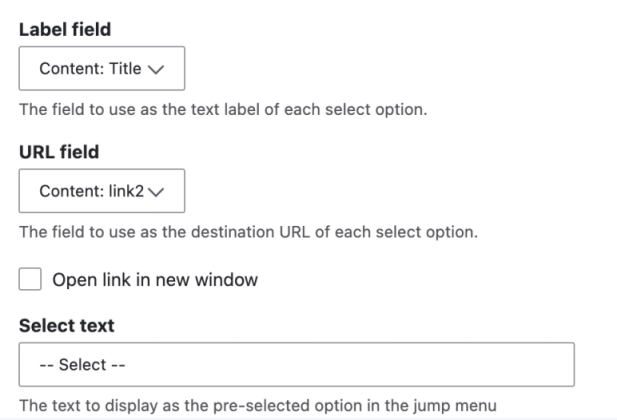
Now set the block to display where you want it and voila! The drop-down select field will appear in it's block and you can select it and it will immediately load the associated page.
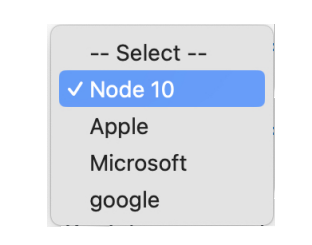
Search multiple fields with a single search box
This core functionality allows a view to have an exposed filter that searches multiple fields for a given search term. It essentially allows you to combine multiple exposed search filters into a single search box.
To set it up include all the fields that you want to search in the Fields section, marking them with Exclude from display as necessary. Then, add and expose a Combine fields filter to the view, and configure it to use all the fields you want searchable in the Choose fields to combine for filtering section of the filter's configuration
Thanks to Mike Anello's blog post outlining this useful feature.
